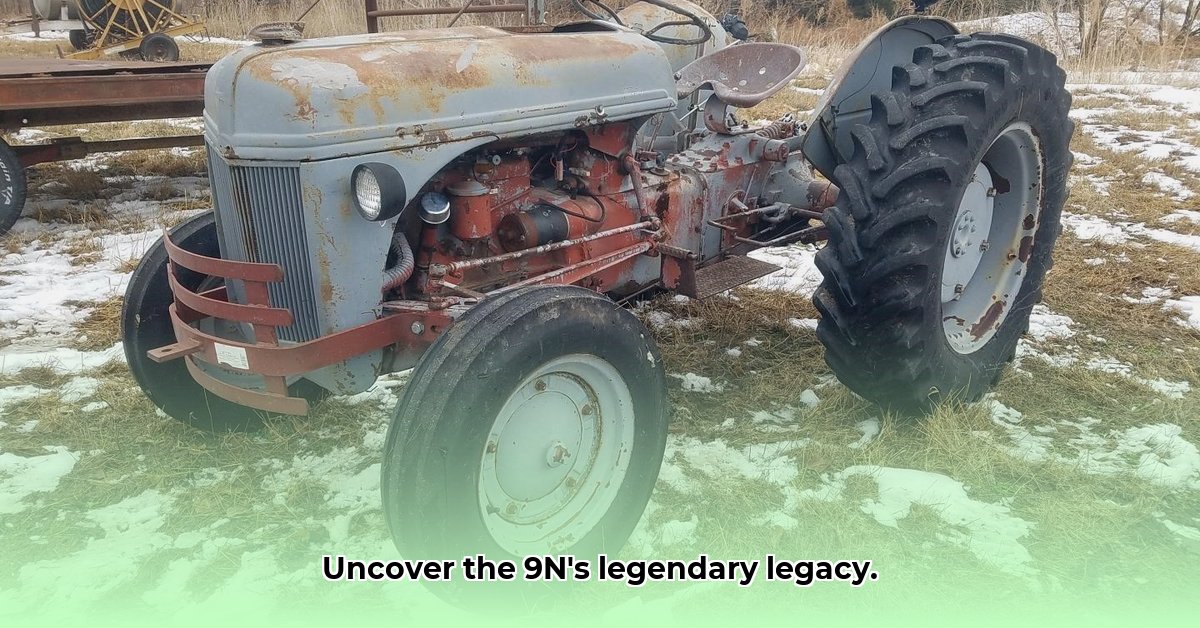
The rumble of a vintage engine, the scent of freshly turned soil – the 1939 Ford 9N tractor evokes a bygone era of American farming. More than just a machine, it was a revolution, democratizing agricultural power and leaving an indelible mark on farming practices. This article delves into the 9N's history, its lasting impact, and practical guidance for restoration and maintenance, appealing to collectors, historians, and enthusiasts alike. For more, check out this great resource: [Ford 9N information](https://4100-ford-tractor.pages.dev).
1939 Ford Tractor 9N: A Revolution in the Fields
The Ford 9N, introduced for approximately $585 in 1939, wasn't merely another agricultural implement; it was a game-changer. Henry Ford's vision of affordable mechanized farming became a reality, transforming the lives of countless American farmers. Its surprisingly low cost and innovative design rapidly propelled it to widespread adoption. Did you know that tens of thousands were produced by 1942, a testament to its enormous impact on agricultural productivity? What other technological advancement saw such rapid expansion during that period?
Ingenious Design: Automotive Innovation Meets Agriculture
Ford’s genius lay in cleverly integrating readily available parts from its automobile production lines. This wasn't a haphazard approach; rather, it was a strategic move that dramatically reduced production costs and simplified maintenance. The integration of automotive components meant that farmers already familiar with car mechanics found repairing and maintaining their tractors easier – a significant advantage in a time when specialized agricultural mechanics were less common. The hallmark of the 9N however, was its revolutionary three-point hitch system, a brilliant innovation allowing for quick and easy attachment of various implements. Some early models even incorporated aluminium parts adding to their rarity and collectability today.
From a Handful to a Nation: The 9N's Rise to Prominence
The 9N's production soared, from a modest number in 1939 to tens of thousands by 1942. This exponential growth reflects the significant need for efficient agricultural machinery. The tractor didn't just boost efficiency; it profoundly altered farming practices, democratizing access to mechanized agriculture and significantly impacting farms of all sizes. It's hard to overstate the 9N's influence on American agriculture; what other invention could claim such a transformative influence in it's time?
A Collector's Prize: The Enduring Allure of the 9N
Today, the 1939 Ford 9N, particularly early models with aluminum components, is a highly coveted collector's item. Finding an original, unrestored example is exceptionally rare, boosting their value significantly within the collector market. What factors account for this enduring appeal beyond their scarcity? Many collectors are drawn to the tractor's unique historical significance, its aesthetic appeal, and the connection to a bygone era of agricultural heritage.
Restoring the 9N: A Step-by-Step Guide
Restoring a 1939 Ford 9N is a challenging but rewarding endeavor demanding mechanical expertise, historical awareness, and considerable patience. It's not a project for the faint of heart; rather it is a labour of love for devoted enthusiasts.
Detailed Restoration Process:
- Comprehensive Assessment: Begin with a meticulous inspection of the tractor, documenting its condition with detailed notes and photographs. A thorough assessment is crucial for planning the restoration process.
- Parts Acquisition: Sourcing original or reproduction parts is paramount. Many parts are still available through specialized suppliers or online communities; others may necessitate custom fabrication.
- Disassembly and Cleaning: Methodically disassemble the tractor, carefully documenting each step with photographs or diagrams to guide reassembly. Thoroughly clean each component.
- Repair and Refinishing: Repair or replace damaged or worn parts. Carefully restore the tractor’s original finish, respecting its historical authenticity.
- Reassembly and Testing: Reassemble the tractor, following the original design specifications or a well-documented restoration plan. Thoroughly test all systems to ensure functionality and safety.
Weighing the Pros and Cons: Owning a 1939 Ford 9N
Owning a classic Ford 9N offers a unique blend of advantages and disadvantages that potential owners should carefully consider.
| Advantages | Disadvantages |
|---|---|
| Historical significance and collector value | Parts sourcing can be challenging |
| Relatively straightforward mechanical design | Requires substantial mechanical knowledge |
| Nostalgic appeal and connection to history | Restoration is labor-intensive and time-consuming |
| Opportunity for hands-on restoration | Lower horsepower compared to modern tractors |
The Enduring Legacy: The Ford 9N's Impact on Farming and Sustainability
The 1939 Ford 9N's influence on farming transcends its technological advancements; its impact on sustainability is undeniable. While not explicitly designed with sustainability in mind, the 9N's efficiency improved resource management. Its impact can't be ignored.
The Three-Point Hitch's Contribution to Efficiency
The 9N's groundbreaking three-point hitch system revolutionized implement attachment. This innovation dramatically increased efficiency, reducing labor time and allowing for more timely planting and harvesting. With minimal downtime, farmers could save time, leading to significantly less crop loss from weather delays, and less waste.
Affordability and Accessibility: Empowering Small Farmers
The 9N's affordability democratized access to mechanized farming, empowering small farmers who previously lacked the resources to use powerful machines. This increased the number of efficient agricultural operations, significantly boosting overall food production.
The 9N's Indirect Influence on Sustainable Farming Practices
The 9N’s design paved the way for future advancements in agricultural machinery, laying the foundation for improvements in fuel efficiency, precision farming, and environmentally friendly equipment. Its legacy extends to present-day efficient and environmentally aware farming practices and techniques.
Maintaining the Legacy: Ongoing Restoration and Maintenance
The ongoing restoration and preservation of the Ford 9N tractors are crucial for maintaining a connection to agricultural history and providing valuable learning opportunities. Careful maintenance, sourcing of original or accurate reproduction parts, and respect for original design enhance both the tractor's longevity and its historical value.
"The Ford 9N wasn't just a tractor; it was a symbol of American ingenuity and a testament to the enduring human spirit," says Dr. Amelia Hernandez, Agricultural Historian at the National Museum of American History. "Its impact on farming practices, efficiency and resource management extends to the principles of sustainability utilized in modern agriculture".